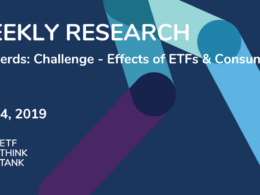This lack of fear scares me. Investors seem to believe that the Federal Reserve will save them, but that seems unlikely to me. I believe the economy is generally in good shape and the low cost of oil acts like a stimulus to the consumer. Additionally, employment and wages continue to improve so it is unlikely that government can artificially prop up the market. Growth stocks are at astronomical valuations as represented by the FANG stocks (Facebook, Amazon, Netflix and Google). Margins on the S&P 500 are over 10% and well above historical norms, which seems unsustainable. I believe that the US equity market will continue to be volatile and the relatively low implied volatility or VIX means this will likely get worse before it gets better.
It is now February 16th and the S&P 500 is down over 8% for the year. That is a significant drop in value considering there have been only 29 trading days in 2016. Even more enlightening is the volatility investors have experienced year to date (YTD).
There are two ways to describe equity market volatility:
1) The VIX, which is designed to measure implied volatility, over the next 30 days. The average value of the VIX is 23 YTD. Put simply, this is what institutional investors expect to happen.
2) Realized volatility or annualized standard deviation (ASTDV) of the S&P 500. So far this year it is 22. Put simply, this is the unpleasant rollercoaster ride equity investors have experienced this year.
Historical Perspective
To put the above numbers in context, the historic realized volatility of the S&P 500 over the past 70 years is around 16 with an average VIX of 18; and over the past seven years it has been closer to 12 ASTDV with an average VIX of 14. My concern is that the market is down significantly, realized volatility is relatively high, and yet the VIX, commonly known as the fear index, is relatively sanguine at 23. So, I ask: “Is this lack of fear scary?”
VIX Defined
When discussing volatility or fear, investment professionals often reference the Chicago Board Options Exchange (CBOE) VIX Index. So I thought we would start by defining it:
“The CBOE Volatility Index® (VIX®) is a key measure of market expectations of near-term volatility conveyed by S&P 500 stock index option prices. Since its introduction in 1993, VIX has been considered by many to be the world’s premier barometer of investor sentiment and market volatility. Several investors expressed interest in trading instruments related to the market’s expectation of future volatility, and so VIX futures were introduced in 2004, and VIX options were introduced in 2006. Options and futures on volatility indexes are available for investors who wish to explore the use of instruments that might have the potential to diversify portfolios in times of market stress.”
Two important points to take away from this description:
1. The VIX is measure of what options traders expect the behavior or implied volatility of the S&P 500 to be in the next 30 days, not a measure of what actually happens or realized volatility. So the VIX does measure fear, but it’s the fears of institutional options traders. So when I, or other investment professionals, reference the VIX, we are describing the institutional opinion of implied or future volatility.
2. Despite the reference to options and futures available for investors, there is no way currently to invest directly in the VIX number. There are different ways to do it indirectly, but there tends to be a heavy cost associated with investing indirectly in the fear index.
Fear is Justified
Let’s now discuss realized volatility or what has actually happened so far in 2016. There have been no periods where the S&P 500 is up more than two days in a row and 16 of the 29 trading days have been negative. This volatility expands the magnitude of down markets through negative compounding. It is important to remember that negative and positive returns are not equal in volatile environments. A loss of 10% requires a gain of 11% to reach breakeven. Realized volatility describes the behavior of returns but also amplifies the negative results. See Appendix A for more examples of the negative results of volatility.
As noted in the introduction, the average VIX over the past 30 days is 23 and realized volatility is 22. That may appear to be pretty accurate prediction, but in my opinion, the VIX is underestimating volatility. Historically, the VIX reacts violently to environments like what we have seen in 2016. For example, from September 2008 to April 2009, the VIX was above 40, in the summer 2011 the VIX was consistently above 30 and as recent as August 2015 its value was over 53. My point is that institutional investors don’t appear to be scared considering how volatile 2016 returns have been thus far.
This lack of fear scares me. Investors seem to believe that the Federal Reserve will save them, but that seems unlikely to me. I believe the economy is generally in good shape and the low cost of oil acts like a stimulus to the consumer. Additionally, employment and wages continue to improve so it is unlikely that government can artificially prop up the market. Growth stocks are at astronomical valuations as represented by the FANG stocks (Facebook, Amazon, Netflix and Google). Margins on the S&P 500 are over 10% and well above historical norms, which seems unsustainable. I believe that the US equity market will continue to be volatile and the relatively low implied volatility or VIX means this will likely get worse before it gets better.
What This Means to Our Clients
Toroso manages portfolios based on three outcomes: Growth, Wealth Preservation and Income. I want to share with our investors how we are preparing for the anticipated volatility in each of these strategies:
1) Growth strategies:
We manage two core growth strategies; the first is our Sector Opportunity portfolio, which combines an 80% allocation to US equity sectors with a volatility ETF overlay. In this portfolio we seek growth through the equity exposure but protect the assets with the volatility overlay. There are many ETFs that seek to provide exposure to the VIX through the use of VIX futures. These ETFs have multiple inefficiencies, but further, the lack of fear this year has made their use even more challenging. The primary ETF we use to protect client assets is Quantshares US Market Neutral Anti-Beta (BTAL). This ETF shorts high beta stocks in the S&P 500 while being long the low beta stocks. It has worked well in this environment as a tail hedge and is up over 12% YTD.
In our second growth strategy, Global Alpha portfolio, we build our core exposure around two ETFs: Alphaclone Alternative Alpha (ALFA) and Direxion Insider Sentiment (KNOW). ALFA seeks to represent the top ideas of hedge funds while tactically providing a hedge by shorting the S&P 500 based on downward momentum. KNOW looks to systematically invest in companies that have relatively high level of insider buying. On Friday February 12th, the market rallied based on the announcement that Jamie Dimon, CEO of JP Morgan (JPM) purchased $26 million in JPM stock, this is the kind of growth KNOW seeks to capture. The universe of equities screened for insider buying in KNOW is first reviewed for forensic accounting anomalies providing protection from fraudulent investments. This initial screen works as the volatility control imbedded in this ETF.
2) Wealth Preservation:
The asset allocation strategy behind our core wealth preservation strategy, the Target Neutral portfolio, is based on the permanent portfolio philosophy. This asset allocation philosophy has been around for 40 years and has produced average annualized returns around 8% with a third of the volatility of the S&P 500. In 2008, this strategy would have been down less than 6%. The portfolio employs four different asset classes, designed to offset the volatility of each other and compound the upside potential of each component: Equities, Bonds, Gold and Cash. This permanent allocation model is how we protect clients from the negative effects of volatility.
The portfolio is performing well in 2016; our core neutral index is up slightly while the S&P 500 is down more than 8%. So far this year, bonds and gold are helping to counteract the negative returns of equities. It is important to note why this strategy produced lackluster returns the last two calendar years. In my opinion, which may sound somewhat arrogant, the market has been irrational. For two years growth stocks have gone up with no respect for valuation fundamentals. During this period, the market did acknowledge this type of unsubstantiated valuations, like the down turn in October 2014 or August 2015, but the market then recovered almost immediately negating the value of diversification. This occurred because investors believed the Federal Reserve would continue to provide economic stimulus. I believe this era of stimulus has ended and our wealth preservation strategy should provide returns similar to the historic norms.
3) Income:
In our Target Income 5% strategy, we combine high yielding ETFs with low risk cash alternatives ETFs. This income “bar-bell” provides lower volatility than traditional bond laddering or blending. In 2015, many high-income assets like Master Limited Partnerships (MLPs) or High Yield Bonds declined substantially. Our approach is significantly more diversified; our core position, Powershares Closed End Fund ETF (PCEF), combines 150 other income funds, each of which has on average of 200 positions, and yields over 9%. We combine these high income ETFs proportionally with low risk funds like the iShares Short-term Treasury ETF (SHY) to target a 5% distribution. Today, our Target Income strategy yields 5.2% while maintaining 49% in low risk ETFs. The combination of diversification and high percentage of low risk ETFs is how we limit volatility for investors.
In Summary
The lack of institutional fear is scary. The economy is in decent shape but I believe that the market is still quite overvalued from a fundamental standpoint. Most probably, the realized volatility will continue and possibly intensify. To quote Benjamin Graham, “in the short term the market is a voting machine, in the long run it is a weighing machine”; when weighed, this market will likely continue to decline. Our outcome driven strategies seek to provide ways for clients to achieve their goal of growth, wealth preservation, or income, while providing protection against realized volatility.
Appendix A
Negative Effects of Volatility
The chart below illustrates the negative effect realized volatility can have on investments. Assume that over 30 days a portfolio experienced 15 days up and 15 days down in equal percentage amounts. The returns are positive one day and negative the next. Pay close attention to how quickly returns deteriorate as the magnitude of volatility increases.
| 30 Trading Days Total Return | Number of Days to a 99% Loss | |
| Up 1% / Down 1% | -0.15% | 105,000 |
| Up 3% / Down 3% | -1.44% | 10,508 |
| Up 5% / Down 5% | -4.69% | 3,726 |
| Up 10% / Down 10% | -13.99% | 918 |
Appendix B
Returns Table – Highlighting the Difference of 29 Trading Days
| Total Returns(Annualized for Periods Greater than 1 Year) | |||||||||||
| YTDas of 2/16/16 | 1 Month as of 12/31/15 | 1 Month as of 2/16/16 | 3 Mos. as of 12/31/15 | 3 Mos. as of 2/16/16 | 6 Mos.as of 12/31/15 | 6 Mos. as of 2/16/16 | 1 Yr. as of 12/31/15 | 1 Yr. as of 2/16/16 | 10 Yrs. as of 12/31/15 | 10 Yrs. as of 2/16/16 | |
| iShares Core US Aggregate Bond ETF (AGG) | 1.79 | -0.34 | 0.97 | -0.61 | 1.97 | 0.60 | 1.28 | 0.48 | 1.27 | 4.36 | 4.57 |
| SPDR® S&P 500 ETF (SPY) | -8.52 | -1.57 | -3.61 | 7.03 | -8.34 | 0.16 | -6.78 | 1.34 | -8.83 | 7.22 | 6.09 |
| iShares S&P 500 Growth ETF (IVW) | -9.49 | -1.53 | -4.91 | 7.81 | -9.36 | 2.56 | -6.00 | 5.33 | -7.09 | 8.52 | 7.34 |
| iShares S&P 500 Value ETF (IVE) | -7.51 | -1.69 | -2.24 | 6.01 | -7.36 | -2.73 | -7.88 | -3.24 | -11.10 | 5.65 | 4.58 |
| FANG Stocks* | -15.06 | -1.53 | -4.93 | 19.75 | -10.05 | 34.76 | 4.70 | 83.23 | 35.21 | ||
| SPDR® Gold Shares (GLD) | 16.66 | 0.00 | 14.18 | -4.74 | 13.90 | -9.47 | 1.02 | -11.78 | 1.00 | 7.12 | 7.90 |
| Toroso Neutral Index** | 2.45 | -0.74 | 3.63 | 0.02 | 2.17 | -2.63 | -1.29 | -2.35 | -1.73 | 5.98 | 6.06 |
* The average of four stocks: Facebook (ticker: FB), Amazon (ticker: AMZN), Netflix (ticker: NFLX) and Google (ticker: GOOGL)
** The Toroso Neutral Index is comprised of four equal weighted ETFs; Vanguard Total Stock Market ETF (VTI), iShares Core US Aggregate Bond ETF (AGG), iShares 1-3 Year Treasury Bond ETF (SHY), and SPDR® Gold Shares (GLD).
Source: Morningstar Direct
Disclaimer — This commentary is distributed for informational and educational purposes only and is not intended to constitute legal, tax, accounting or investment advice. Nothing in this commentary constitutes an offer to sell or a solicitation of an offer to buy any security or service and any securities discussed are presented for illustration purposes only. It should not be assumed that any securities discussed herein were or will prove to be profitable, or that investment recommendations made by Toroso Investments, LLC will be profitable or will equal the investment performance of any securities discussed. Furthermore, investments or strategies discussed may not be suitable for all investors and nothing herein should be considered a recommendation to purchase or sell any particular security. Investors should make their own investment decisions based on their specific investment objectives and financial circumstances and are encouraged to seek professional advice before making any decisions. While Toroso Investments, LLC has gathered the information presented from sources that it believes to be reliable, Toroso cannot guarantee the accuracy or completeness of the information presented and the information presented should not be relied upon as such. Any opinions expressed in this commentary are Toroso’s current opinions and do not reflect the opinions of any affiliates. Furthermore, all opinions are current only as of the time made and are subject to change without notice. Toroso does not have any obligation to provide revised opinions in the event of changed circumstances. All investment strategies and investments involve risk of loss and nothing within this commentary should be construed as a guarantee of any specific outcome or profit. Securities discussed in this commentary, including the ETFs presented in the Appendix, were selected for presentation because they serve as relevant examples of the respective points being made throughout the commentary. Some, but not all, of the securities presented are currently or were previously held in advisory client accounts of Toroso and the securities presented do not represent all of the securities previously or currently purchased, sold or recommended to Toroso’s advisory clients. Upon request, Toroso will furnish a list of all recommendations made by Toroso within the immediately preceding period of one year.












